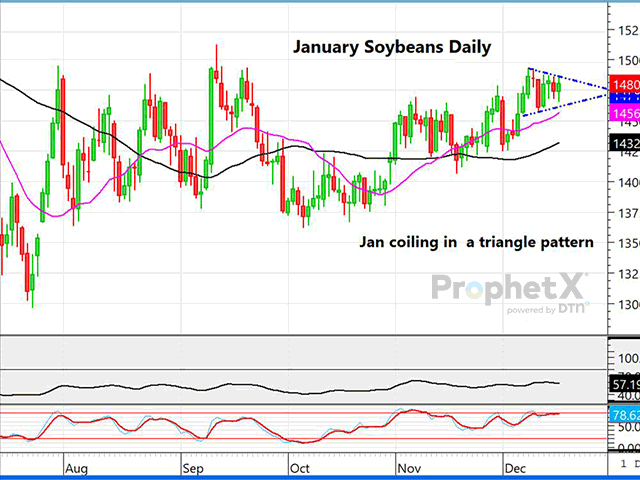Technically Speaking
January Soybeans Coiling in a Symmetric Triangle Chart Pattern
The January soybean pattern below is a symmetrical triangle, with the market undecided on which way this pattern will evolve. Typically, the pattern is a continuation pattern in the prevailing trend, which in this case would be inclined to resolve to the upside. However, there are bullish and bearish considerations for soybeans, so there is little confidence in the ultimate outcome.
Although January beans remain in a solid uptrend, the sideways trading triangle chart pattern suggests indecision. On the bullish side, recent good export business to China and unknown, the continued bullish profit margins in domestic crush and the ongoing drought conditions in Argentina, have combined to send soybeans higher. However, looming in the background is the favorable weather in much of Brazil, and calls for a record large (by far) Brazil soy crop, and extended forecasts hinting at the end of La Nina, and Argentina's drought pattern, are longer-term bearish. Currently, the combined production for Argentina and Brazil is expected to be as much as 30 mmt (1.1 billion bushels) higher than a year ago if weather cooperates. The $15 level should be one of solid resistance, but a close over $15.12 would likely negate the bearishness. A break and close under the 20-day moving average at $14.58 would likely lead to further weakness.
P[L1] D[0x0] M[300x250] OOP[F] ADUNIT[] T[]
With the lowest U.S. and world supplies of wheat at a 15-year low, the recent weakness in wheat markets has been baffling to many traders. Granted, with Russia and Ukraine continuing to offer cheap wheat to the world, U.S. wheat exports have suffered, with current sales down 7% from a year ago. However, there is still an ongoing severe drought in the southwestern Plains, and the Argentine wheat crop has plunged nearly 9 mmt (331 mb) from early season projections, so wheat markets may very well be underpriced currently. The dangerous net short fund position that funds are carrying in Chicago wheat, reflecting the shortest since May of 2019, would give fuel to any bullish fire on a rally. It's not a matter if, but when the wheat market moves sharply higher. But for now, the bearish fund managers are enjoying life.
MARCH SOYBEAN MEAL FUTURES:Early on Monday, the March soybean meal contract is down hard and appears to be breaking out of a bear flag chart pattern. That would suggest much lower prices ahead. The recent rally in meal has been fueled not only by unwinding of the sizable long bean oil/short bean meal position by funds, but also by the expanding dryness in Argentina. Forecasts for the weekend have rain chances increasing for Argentina and that is likely driving Monday's weakness.
**
Comments above are for educational purposes and are not meant to be specific trade recommendations. The buying and selling of grain and soybean futures involve substantial risk and are not suitable for everyone.
Dana Mantini can be reached at Dana.Mantini@DTN.com
Follow him on Twitter @mantini_r
(c) Copyright 2022 DTN, LLC. All rights reserved.






Comments
To comment, please Log In or Join our Community .